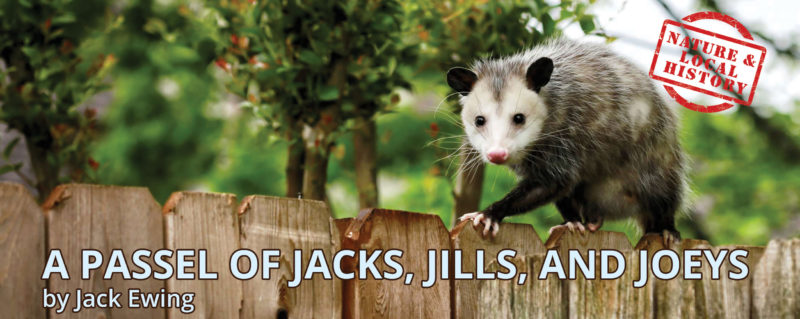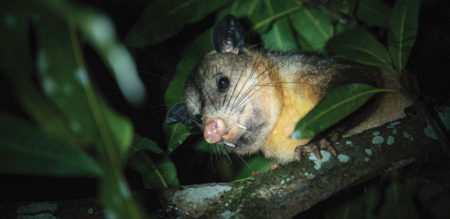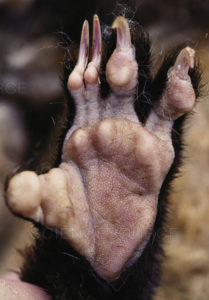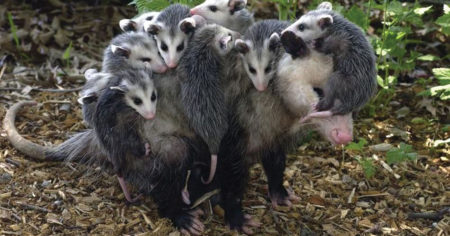A Passel of Jacks, Jills, and Joeys

I have seen lots of Jacks and Jills and even a few Jills with bunches of Joeys, but I have never seen a passel. In fact I just recently learned what one was. I know you have heard of a pride of lions, a herd of elk, and a troop of monkeys, but how about a passel of opossums. Since these mammals are solitary by nature and don’t hang out in groups, I doubt if the word sees much use. Jacks, of course, are the males, Jills the females, and Joeys the babies. I don’t know if a Jill with a bunch of Joeys on her back is considered to be a passel or not. If so then I guess I have seen a passel.
 The common opossum (Didelphis marsupialis) is a nocturnal, marsupial mammal found throughout this part of Costa Rica. They are not the least bit charismatic, and certainly won’t win any beauty contests. Being stinky when up close doesn’t win them any fans either. The Bribri Indians even consider them to be messengers of death. Not being picky about their food often gets them into trouble with urban dwelling humans for invading garbage cans. Rural families despise them for raiding chicken coops, killing chickens, and eating eggs. They will eat almost anything from fruit and grass to birds, insects, small reptiles and even carrion. With a diet as diverse as that they need lots of teeth of many different kinds. Opossums have more teeth than any other mammal. There are 50 in total including incisors, premolars, molars, and canines.
The common opossum (Didelphis marsupialis) is a nocturnal, marsupial mammal found throughout this part of Costa Rica. They are not the least bit charismatic, and certainly won’t win any beauty contests. Being stinky when up close doesn’t win them any fans either. The Bribri Indians even consider them to be messengers of death. Not being picky about their food often gets them into trouble with urban dwelling humans for invading garbage cans. Rural families despise them for raiding chicken coops, killing chickens, and eating eggs. They will eat almost anything from fruit and grass to birds, insects, small reptiles and even carrion. With a diet as diverse as that they need lots of teeth of many different kinds. Opossums have more teeth than any other mammal. There are 50 in total including incisors, premolars, molars, and canines.
In spite of their bad reputation opossums are really pretty interesting. Let’s take, for example, the fact that they are immune to snake bite. Scientists have been searching for the source of this immunity for some time and have recently discovered a chain of amino acids in their blood serum that appears to neutralize snake venom. The really good news is that they have been able to pass this form of immunity on to mice in a laboratory, and there is hope that someday soon it will be available for snake bite treatment in humans.
 When I was in school in about the seventh or eighth grade our science teacher told us how special humans are because we have an opposable thumb. Because of this superior trait we can do all sorts of things that other animals can’t, we were told. As kids we used to joke about how special we were because of our opposable thumbs. What a disappointment when I learned that opossums also have opposable thumbs, but only on their hind feet.
When I was in school in about the seventh or eighth grade our science teacher told us how special humans are because we have an opposable thumb. Because of this superior trait we can do all sorts of things that other animals can’t, we were told. As kids we used to joke about how special we were because of our opposable thumbs. What a disappointment when I learned that opossums also have opposable thumbs, but only on their hind feet.
The family Didelpidae, which includes 8 species of opossums in Costa Rica, are the only family of marsupials in the in the Americas. Most of the rest, kangaroos, koalas, wombats, and bandicoots among others, live in Australia. This is the only order of mammals to carry their young in a pouch located on the mother’s belly. The young, which are more like a fetus than a baby at birth, need to live in the warm nurturing environment of the marsupial mother’s pouch for a couple of months before venturing out into the world.
 Nobody knows when or by whom it was discovered that a male opossum has a two pronged penis. This interesting bit of knowledge gave rise to the belief that the Jack mates with the Jill’s nose, and when the Joeys are born she sneezes them into her pouch. I first read about this folkloric belief on internet and got the impression that it was referring to backwards areas of the United States. Later I found that the belief used to be common among the rural residents in this part of Costa Rica.
Nobody knows when or by whom it was discovered that a male opossum has a two pronged penis. This interesting bit of knowledge gave rise to the belief that the Jack mates with the Jill’s nose, and when the Joeys are born she sneezes them into her pouch. I first read about this folkloric belief on internet and got the impression that it was referring to backwards areas of the United States. Later I found that the belief used to be common among the rural residents in this part of Costa Rica.
The truth of the matter is only slightly less astonishing than the belief. The Jack does have a forked penis, and the Jill has two vaginas and two wombs. A pair of opossums mating appears pretty much the same any other pair of mammals mating (not in the nose). The Joeys are born only 12 to 14 days after mating. Birth takes place through a third canal that forms temporarily solely for this purpose and then disappears. At birth the Joeys are so tiny, about the size of a pea, that they are sometimes referred to as larvae rather than babies. Nevertheless they are mobile and able to crawl from the birth canal through the hair on the Jill’s lower belly to the pouch where they enter and search for a nipple of which there are about 10. There is no sharing, only one Joey per nipple. When the larva grabs the nipple it instantly swells, locking itself into the larva’s mouth. There it will remain, unable to let go, for a couple of months until it is mature enough to venture outside. After that the Joeys often ride on mom’s back. Around 20 Joeys will be born, but only those who are fast enough and strong enough to find the pouch and a nipple will survive. The rest perish.
 The oldest marsupial fossils yet to be discovered are about 75 million years old. These mammals are survivors. They were here before the demise of the dinosaurs, and they survived the catastrophe that ended the reign of those huge reptiles. It has crossed my mind that the opossums could be considered the cockroaches of the mammal world. Like those unsavory little beetle-like insects, they are generally despised, will eat almost anything, have been around a long time, have survived great upheavals, and they are still going strong.
The oldest marsupial fossils yet to be discovered are about 75 million years old. These mammals are survivors. They were here before the demise of the dinosaurs, and they survived the catastrophe that ended the reign of those huge reptiles. It has crossed my mind that the opossums could be considered the cockroaches of the mammal world. Like those unsavory little beetle-like insects, they are generally despised, will eat almost anything, have been around a long time, have survived great upheavals, and they are still going strong.
And opossums really do “play possum”. When threatened, and with no avenue of escape, they will lie still, mouth open, tongue hanging out, slow their breathing, and remain this way for as long as several hours. This may buy them some time and an opportunity of escape.

